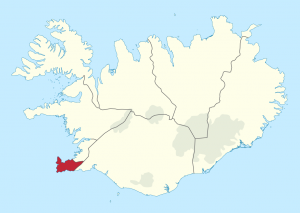 Southern Peninsula (Icelandic: Suðurnes) or Reykjanesskagi (pronounced [ˈreːicjanɛsskʰajI]) is a region in southwest Iceland. It was named after Reykjanes, the southwestern tip of Reykjanesskagi. The region has a population of more than 22,000 and is one of the more densely populated parts of the island. The administrative centre is Keflavík, which had 7,000 residents when it merged with the nearby town of Njarðvík several years ago to create Reykjanesbær, which is the second largest settlement outside the Greater Reykjavík area; on 1 January 2013 the town had a population of 14,231.
Southern Peninsula (Icelandic: Suðurnes) or Reykjanesskagi (pronounced [ˈreːicjanɛsskʰajI]) is a region in southwest Iceland. It was named after Reykjanes, the southwestern tip of Reykjanesskagi. The region has a population of more than 22,000 and is one of the more densely populated parts of the island. The administrative centre is Keflavík, which had 7,000 residents when it merged with the nearby town of Njarðvík several years ago to create Reykjanesbær, which is the second largest settlement outside the Greater Reykjavík area; on 1 January 2013 the town had a population of 14,231.
The region is the location of Keflavík International Airport, the major point of entry for Iceland, and also the Blue Lagoon health spa.
The peninsula is marked by active volcanism under its surface, and large lava fields, allowing little vegetation. There are numerous hot springs and sulphur springs in the southern half of the peninsula, around the Kleifarvatn lake and the Krýsuvík geothermal area.
There is also a geothermal power station at Svartsengi. Near the power station a swimming pool has been installed using the hot and mineralized water coming down from the power station; it is known as the “Blue Lagoon” (Bláa Lónið).
The Leif the Lucky (or Miðlína) Bridge spans the Álfagjá rift valley (60 feet wide and 20 feet (6.1 m) deep) near Grindavik, which marks the boundary of the Eurasian and North American continental tectonic plates. It was built in 2002 and named in honor of Icelandic explorer Leif Eriksson who traveled from Europe to America 500 years before Columbus.
Some fishing towns, such as Grindavík and Njarðvík are situated on the peninsula as well as the town of Keflavík, the site of Keflavík International Airport and the Leifur Eriksson Air Terminal and the former American military base.
Towns – Other destinations – Understand – Talk – Get in – Get around – See – Do – Eat and Drink – Stay safe
